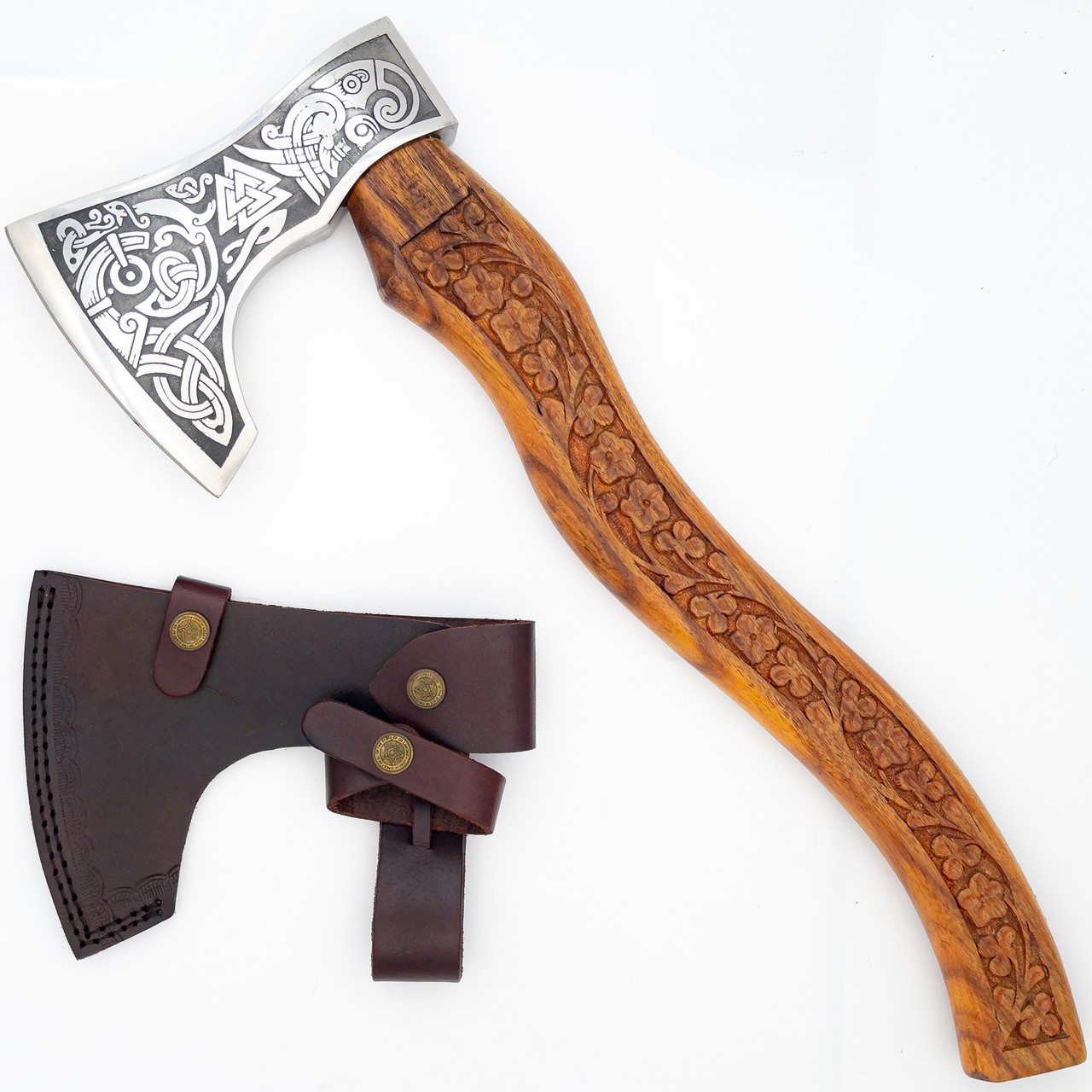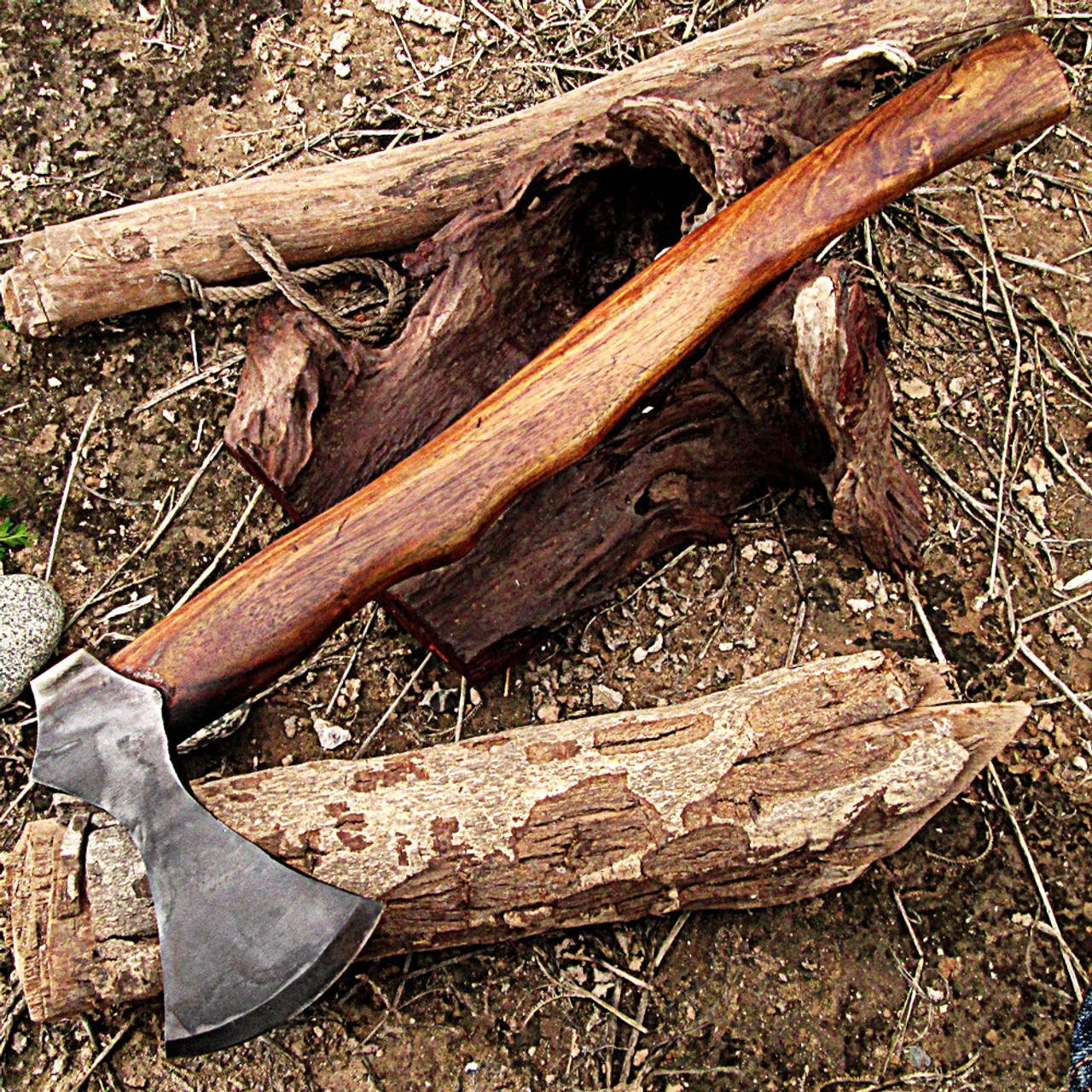You Won't Believe What These Medieval Axes Were Used For
Posted by Swordsswords on Feb 13th 2024
When we think of a medieval axe , we see visions of clashing steel and fearsome warriors. But the truth is, this iconic weapon was far more versatile than Hollywood portrays.
They weren't just instruments of destruction, but ubiquitous tools that shaped everyday life in medieval society. From felling towering trees to crafting intricate furniture, the medieval axe played a surprising and diverse role.
So get ready to have your viking axe umptions shattered, as we delve into the unexpected ways these handy (and sometimes not-so-handy) tools were used throughout the Middle Ages. From battlefield brutality to carpentry creativity, we will discover the fascinating, and often surprising, story of the medieval battle axe!
The Medieval War Axe Unexpected Combat Roles
While the clash of steel on the battlefield might be the axes most romanticized role, its combat utility went far beyond hacking heads. It was a versatile warrior, adapting to various battlefield needs:
Infantry Powerhouse: The axes heft offered devastating close-quarters strikes, making it a favorite among foot soldiers. The bearded axe , with its hooked blade, could disarm opponents and deliver brutal blows. Vikings wielded fearsome Dane axes , capable of splitting shields and cleaving armor.
Breaching Brute: Sieges weren't won with swords alone. Axes served as potent breaching tools, smashing through gates and fortifications. Wider blades like the boarding viking battle axe were designed specifically for breaking down wooden defenses.
Cavalry Companion: Though less common, battle ready axes found their place mounted warriors' arsenals. Pollaxes, with hammer-like extensions, were effective against armored foes, while franciscas, throwing axes , could harass enemies from afar.
Famous Figures, Fearsome Feats: History echoes with the clang of legendary axes. Vikings like Ragnar Lothbrok inspired awe with their berserker fury, while Richard the Lionheart embodied knightly prowess with his trusty medieval axe . These figures remind us of the axe's potent presence on the medieval battlefield.

The Medieval Axe's Vital Role in Construction and Carpentry
While the battlefield might have sung praises of the axe's ferocity, medieval society relied heavily on its tamer side in construction and carpentry. From towering cathedrals to humble homes, the axe played a crucial role in shaping the built environment:
Woodcutting Workhorse : The journey from forest to construction began with the felling axe. Its sturdy design allowed for efficient tree felling, providing the raw material for countless projects.
Shaping Timber: Once felled, the wood needed refinement. The broadaxe , with its wide, flat blade, excelled at hewing logs into square timbers, essential for building frames and beams.
Carpentry Companion: Smaller, specialized axes found their niche in carpentry. The adze, with its blade perpendicular to the handle, smoothed curved surfaces, while the chisel axe offered precision for delicate joinery work.
Building Bridges, Not Just Battles: From the magnificent oak roofs of Westminster Abbey to the intricate half-timbered houses of Germany, numerous iconic medieval structures stand testament to the axe's contribution. Even intricate ships, vital for trade and exploration, were crafted with the help of these versatile tools.
Beyond Brick and Mortar : Axes weren't limited to grand structures. Carts, furniture, tools, and even toys relied on the axe's shaping abilities. Imagine a medieval craftsman, axe in hand, meticulously carving a intricate chessboard or shaping a sturdy chair leg.
The Ubiquitous Medieval Axe in Everyday Life
Step away from the battlefield, for the medieval axe had a surprisingly domestic side. It wasn't just a warrior's companion; it was an essential household tool, woven into the fabric of everyday life:
Butcher's Best Friend: Forget fancy cleavers. The axe, with its sturdy blade, served as the butcher's trusty tool for dismantling livestock and preparing meat. From chopping bones to cleaving sides of beef, the axe tackled diverse butchering tasks.
Firewood Frenzy : Keeping warm in drafty medieval homes depended on a reliable firewood supply. The felling axe and splitting axe became winter warriors, transforming logs into kindling and firewood, keeping hearths roaring and families warm.
Furniture Fashioner: Imagine a carpenter crafting a beautiful chest, not with saws but with an axe! The adzed axe and chisel axe were masters of shaping furniture elements, adding intricate details and smooth finishes to chairs, tables, and chests.
Beyond the Basics: From chopping vegetables to trimming hedges, the axe's versatility extended to even more mundane tasks. Imagine a farmer using a small axe to clear brush or a housewife splitting kindling for the kitchen fire.
From Battlefield to Blessing: The Axe's Unexpected Ceremonial Roles
While the clang of combat might define the axe's image, it also held a place in rituals, ceremonies, and symbolism, transcending its practical uses:
Sacred Symbolism : In Norse mythology, Thor wielded the mighty Mjolnir, a hammer-axe symbolizing thunder and protection. Similarly, Celtic cultures associated axes with deities and rituals. These connections highlighted the axe's deeper spiritual and symbolic significance.
Ceremonial Splendor : Elaborately decorated axes, often adorned with precious metals and jewels, served as symbols of power and authority. Kings carried ceremonial axes during coronations, and guilds used them in official processions. These axes transcended tools, becoming powerful statements.
Ritualistic Roles : Axes featured in various rituals. Vikings used them in sacrifices and burials, while other cultures employed them in blessing ceremonies and land consecration. The axe's presence added weight and symbolism to these sacred acts.
Beyond Europe : Across the globe, axes held cultural significance. Native American tribes used them in ceremonial dances and storytelling, while African cultures associated them with spiritual power and leadership. This showcases the axe's diverse symbolic roles across civilizations.
Examples of Uniqueness : The Danish Axe , adorned with silver and featuring intricate carvings, exemplifies ceremonial artistry. In contrast, the Aztec Tezcatlipoca's obsidian axe, shaped like a crescent moon, reflects its connection to deities. These diverse examples highlight the axe's adaptability in ceremonial contexts.

The Medieval Axe: More Than Just a Weapon, a Way of Life
So, step aside Hollywood stereotypes! The medieval axe was far more than a battlefield brute. It was a versatile tool woven into the very fabric of medieval life, from felling towering trees to crafting intricate furniture, butchering meat to shaping destinies.
Now, you can own a piece of this captivating history with authentic medieval axes for sale from swordsswords.com! More than just wall hangers, our axes are crafted with the same meticulous attention to detail and historical accuracy that defined their medieval counterparts. Explore our diverse collection, from battle ready warriors to ornate ceremonial pieces, and discover the axe that speaks to your soul.

